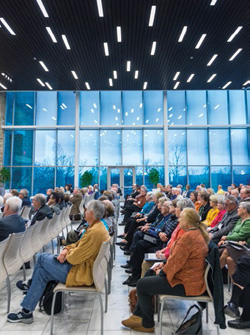
The Helmerich Center for American Research celebrated its public opening on March 27- 28, 2015, with the inaugural symposium, “The Gilcrease Archives: Unlocking the History of the Americas.”
Ten highly respected scholars spoke to an enthusiastic audience on the significance of individual and collective treasures in the Gilcrease archives. Some of the treasures are quite well known such as the Codex Canadensis, a 17th century manuscript that documents the flora, fauna and indigenous people of New France along the St. Lawrence at a time when it was virtually unknown to the rest of the world. Dr. Germaine Warkentin, University of Toronto, described why the document, which was written and illustrated by Jesuit priest Louis Nicolas, is so revered in Canada, and how after more than a half century of research by French Canadian scholars, much can still be learned from new studies of this important manuscript.
Other documents such as the Luke Foxe Nautical Journal of 1631, described by Jonathan King, University of Cambridge, are virtually unknown. Like his nautical predecessors, Foxe sought to find the Northwest Passage that might offer a more direct route from Europe to Asia than sailing around Africa or South America. The exploration of the Canadian Arctic by Foxe and his failure to find a navigable passage changed nautical history for the next 250 years.
The Spanish Colonial records in the Gilcrease archives described by Roy Ritchie, Huntington Library, contain more than 100,000 pages of documents from the 16th and 17th centuries. The documents, most of which have yet to be translated into English, chronicle the Spanish exploration and conquest of the Western Hemisphere and provide insight into religious persecution during the Mexican Inquisition. A few documents were written by or to some of the most memorable names in history including Diego Columbus, Hernando de Soto, Hernán Cortés and Ponce de León.
The importance of historic maps in the Gilcrease collections was clearly demonstrated by the presentations “The Battle for the Americas as seen through Maps,” by TU Professor Thomas Foster and “Maps: Witnesses to History,” by Dr. Ralph Ehrenberg, chief, Geography and Map Division, Library of Congress.
Cultural contact and conflict were the underlying themes of several presentations. TU Professor Kristen Oertel examined original documents in the collection dating from 1512 to 1863 to explore the conflict over slavery, and Professor Brian Hosmer explored the Miami struggle for sovereignty in the 19th century through the Thomas Richardville papers. Dr. Herman Viola, from the National Museum of the American Indian, Smithsonian Institution, spoke on the “Indian Legacy of Charles Bird King,” reminding us of the importance of the 19th century Indian portraits by King in the Gilcrease collection since most of his work was destroyed in the Smithsonian fire of 1865.